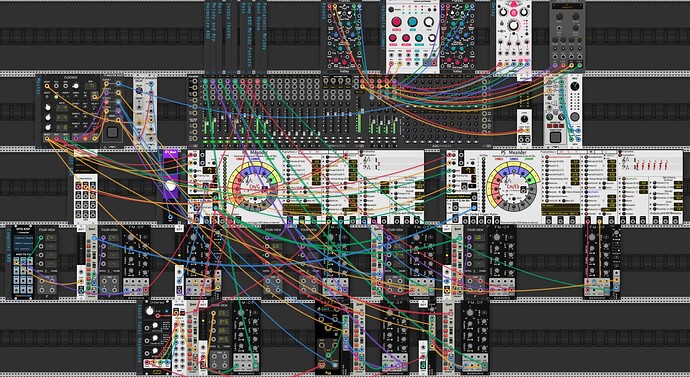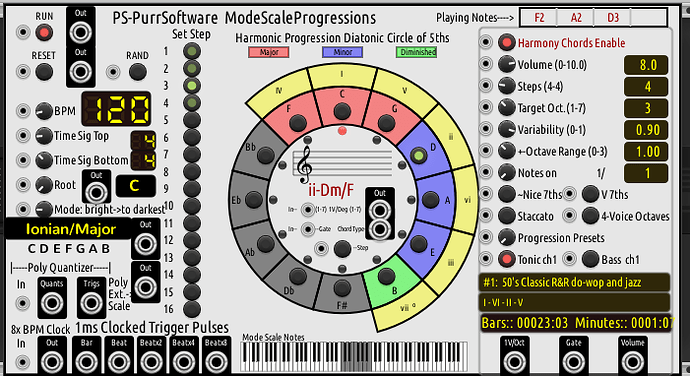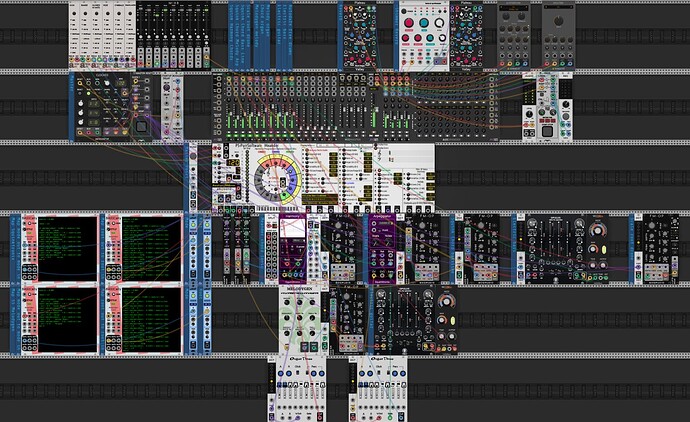Here is something a bit different for me. In this, I am playing a MIDI keyboard with my left hand to send octal radix scale intervals to the Meander melody DEGREE input with this Meander quantized to Cmin diatonic scale. The melody is then harmonized by the Forsitan Modular Interea and then arpeggiated with the AH ARP3.1 . With my right hand I am playing the computer keyboard MIDI melody part which is quantized to the Cmin pentatonic scale of the 2nd Meander module.
And, a lot of “stuff” is happening, This is the what I developed Meander for in 1988… to be a computer aided performance device. Of course, Meander for VCV Rack is much, much more sophisticated than the original Meander.
I am including the patch for those interested, although it is a pretty complex patch to understand and play: A Blues Noodle Meander in Cmin.vcv (18.3 KB)
Here is my live performance:
this is quiet wonderful to play with. to turn all the knobs may take a while and every constellation really sounds so relaxed.
but you are right: it is difficult to understand what is going on in detail. ![]()
Yes, I agree that this patch is complex to the point of incomprehensibility. But maybe it will stimulate some other experiments.
Currently, I have modified this keyboard patch to work with my Jamstik MIDI guitar by doing a zone split on the MIDI data from the Jamstik such that the upper 3 strings (or so) note data is routed to one place in the patch and the lower 3 strings data is routed to another place in the patch… To get this to work, I have to set up the Jamstik MIDI channel in Rack to monophonic and not 7 channel MPE
I’m not sure how useful this will be, but it sure is fun. I will post the patch at some point in case anyone wants to play with it.
Hmm, MPE shouldn’t make much of a difference for keyboard split because you split by note rather than by channel.
I could have merged the 7 MPE channels into a single VCV “channel” and maybe MPE could work, but as it was, it was logically too complicated to have the guitar notes arriving on 7 channels, even though I only wanted a single note channel of v/oct data per split. This is fine for playing lead guitar. If I wanted to split chords, all sorts of logic problems arrive.
I may come back to chords eventually.
I have submitted PS-PurrSoftware V2.0.29 for library review. For this version, I added a second module to Meander and called it ModeScaleQuant (MSQ). MSQ uses musical nomenclature and interface similar to Meander so should be very easy to understand for anyone familiar with Meander. MSQ is simple as just a polyphonic input quantizer with polyphonic note and trigger outputs. Like Meander, it is based on the modern “modes” of music theory and common practice and relates back to the diatonic circle of fifths. Meander and MSQ modules can be chained if desired via the MODE and ROOT outports and inports.
I added a piano keyboard display to show the scale notes for MSQ and also added that to Meander. It is underneath the circle of 5ths widget on the panel. So, the modal (mode and root) scale can be seen as text, as musical staves key signature and as piano keyboard display. This is mostly for those wishing to learn a bit more about modal scales and the circle of fifths.
In doing this, I also changed the default mode and root behavior in Meander and MSQ that users should be aware of. I think all existing patches will play unchanged, but for new patches or editing old patches, the modules now default to the pure modal root when the mode is changed. In the pure or natural form, each mode has a natural root which results in the mode scales being be made up only of white notes on the piano keyboard but with a different root or tonic scale first note. After the mode is set, you can still transpose the mode to any of the 12 chromatic keys and that info will persist in patch save and load. If you change the mode manually, the root will also change to the natural tonic but you can reset the root to whatever key you want.

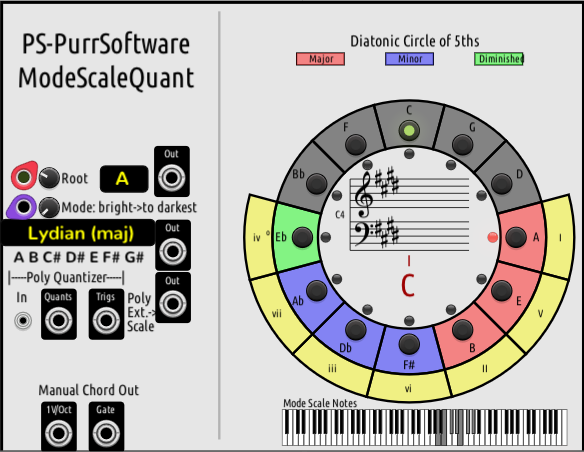
I am unlikely to add much more to Meander in the future as I think the panel is “full” ![]()
Oh yeah, MSQ allows the user to click on the circle of fifths button lights to play a triad chord in that scale. The “Manual Chord Out” outports provide the polyphonic chord which you can send to voice module for playing around with song composition in various modal scales and see what is happening relative to the circle of fifths. I like to use BGA FM-OP.
For the quantizer trigger outputs, I often use a a BGA DGATE module to extend the trigger into a duration gate signal.
PS-PurrSoftware plugin V2.0.29 is live in the VCV library now. As mentioned above, there is a new module, ModeScaleQuant joining my Meander module in the plugin.
I wonder if this means it it available for the Arm64 architecture.
Yes. It is available for arm64.
If it didn’t build for Mac ARM, I’d expect an issue in your repo from cschol, so you’re probably good to go. I recommend using qno’s github actions & toolchain so that you can verify all 4 Rack targets build correctly.
I old school. I use the tool chain in Linux on my pc.
I have submitted a quick fix release for my plugin for library review. I forgot to update the modules’ PNG file which is used when you browse your local modules and Meander had some double images of two jacks inside of the circle-of-fifths. This was purely cosmetic.
By the way, I am working on developing a new module named ModeScaleProgressions. This is functionally the left side of the Meander module with harmonic progressions but not melody, bass and fBm output. I have it working but am still working on some panel issues, so this image is actually just a snip of Meander but is very close to how the new module will look and work. Hopefully there will be some users interested in just having modal chord progressions without all of the rack space taken up by Meander.
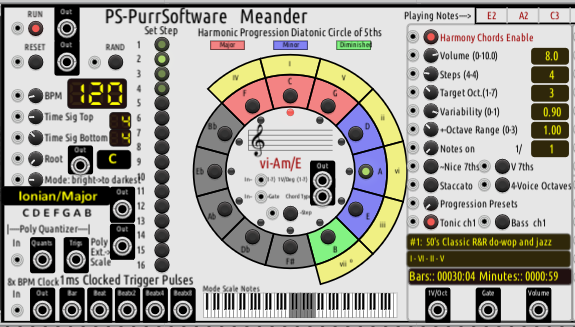
The time signature is less important for a chord progression engine, but I left it in. ModeScaleProgressions will work via chaining of root and mode between it and Meander and ModeScaleQuant.
Here is the “finished” ModeScaleProgressions module. I will do more testing before submitting to the library.
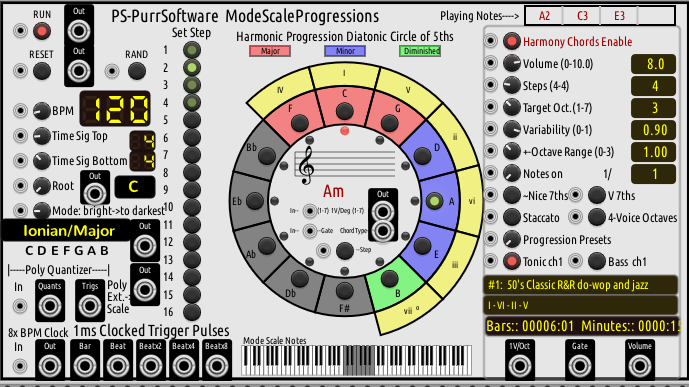
Well, in my testing I found some panel UI issues related to the new feature for all my modules of displaying the degree (I-VII) for each chord played. In the above image, the degree was not displayed. Also, if an “invalid” circle position is clicked upon, the chord will be displayed in a panel text color rather than red and will leave off the degree indicator.
These changes affect all 3 of my modules and they are all now consistently behaved.
PurrSoftware plugin V2.0.31 is now in the library. This was a cosmetic cleanup and fix release only.
PurrSoftware plugin V2.0.32 has been submitted for library review. This version adds the new module “ModeScaleProgressions” and does UE/UI cleanup for all 3 modules for usability and consistency.
Here is my new music with Meander, Squinkytronix Harmony and Arpeggiator, and Alef’s Bits Slip modules. In this, Meander is the conductor, setting the mode and root scale (Am) and generating a traditional 12-bar blues chord progression. Four Stochastic Telegraphs’s BASICally modules and scripts provide the mapping between all of the modules and mode and root. Each of the named modules are playing parts of the harmony, melody and bass parts.
Beware, this patch uses modules that are still in beta testing tweaking.
@Squinky @alefnull @StochasticTelegraph
Meander Squinky and Alef Blues.vcv (15.3 KB)
That’s a really nice piece Ken. Great feel to it and sounds very “human played” which is always a feat I think. Almost sounds like a John Carpenter interlude in a film, whether you planned that or not, but that’s a big kudos in my book.
Thanks Lars. I really didn’t have anything in mind when I started this. I rely on emergent patterns.
Here is some new music that is a bit different. This was created generatively by Meander, Squinkytronix Harmony and Arpeggiator, SS Modules’ Melodygen and a dose of Vult and Surge and Stochastic Telegraph for mapping. This is a traditional 12-bar blues in Am progression.
Meandering Blues.vcv (13.8 KB)
